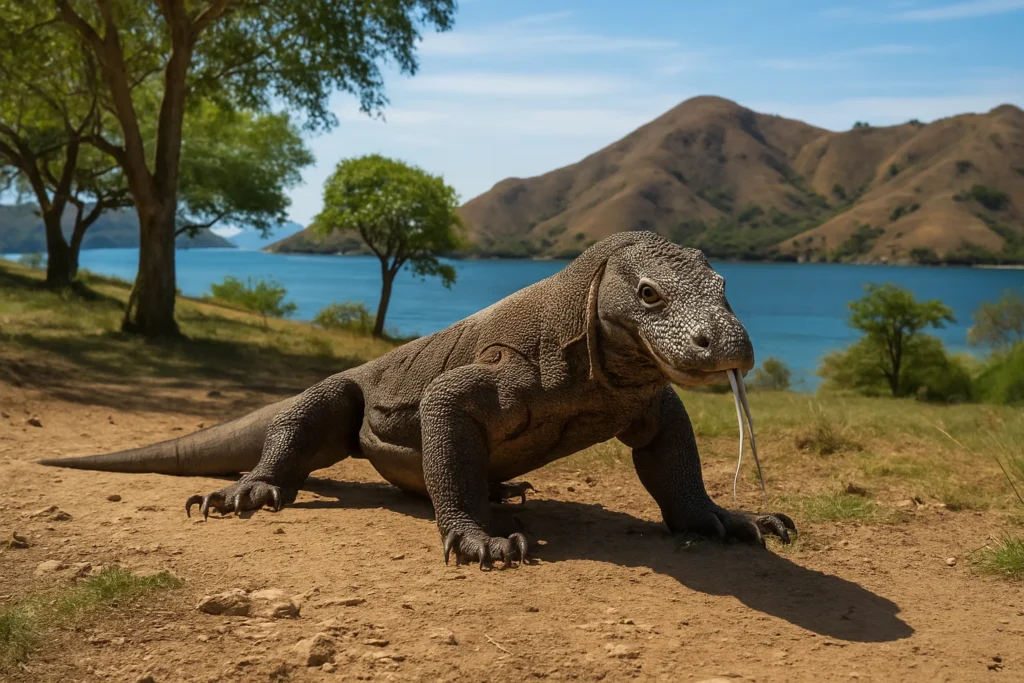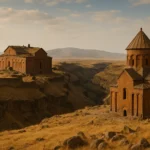The Living Legend of Komodo: A Prehistoric Kingdom Under Siege
Beneath the relentless equatorial sun, where the Flores Sea meets a chain of rugged, volcanic islands, an ancient and formidable predator reigns supreme. The Komodo dragon (Varanus komodoensis), the undisputed monarch of this wild kingdom, is Earth’s largest living lizard and a true living legend. This magnificent beast has defied the laws of time, surviving virtually unchanged for over 4 million years. It has outlasted the colossal mammals of the Pleistocene epoch and stood as a silent witness to the entire span of human civilization. Today, fewer than 3,000 of these magnificent creatures remain, all confined to a handful of Indonesian islands within the boundaries of Komodo National Park.
This designated UNESCO World Heritage Site is far more than just a home for the dragons; it is a sprawling, biologically rich sanctuary encompassing 1,817 square kilometers of diverse habitats. From the arid savannahs that shimmer under the midday sun to the lush tropical forests and the vibrant, teeming coral reefs below the turquoise surface, the park is a masterpiece of biodiversity. Its unique ecology supports a breathtaking array of life, including 72 species of birds, a staggering 1,000+ fish species in its marine protected areas, and endemic mammals like the Rinca rat and the Timor deer, which serves as the Komodo dragon’s primary prey. This complex web of life has evolved in isolation, creating a truly unique and irreplaceable ecosystem.
The Gathering Storm: When a Blessing Becomes a Burden
The fragile existence of this ancient species is under assault from a trifecta of modern threats, each one a consequence of human activity. The first, and most visible, is the tourism tsunami. Between 2010 and 2020, visitor numbers exploded by 400%, reaching a peak of 176,830 tourists in 2019 before the pandemic temporarily halted travel. However, the post-COVID travel surge brought with it even greater pressures. The daily impacts were devastating: over 300 boats anchoring in fragile marine ecosystems, the volume of plastic waste increasing by 28% annually, and incessant foot traffic causing trail erosion that exposed vulnerable dragon nests to predators and the elements. Most critically, the dragons’ primal hunting behaviors were being disrupted as they began to associate humans with a source of easy food, a dangerous shift that threatened their survival skills.
The second threat is a sinister and clandestine one: the black market menace. A 2022 INTERPOL report revealed a disturbing trend in the trafficking of Komodo dragons and their body parts. The illegal wildlife trade saw live specimens sold for as much as $50,000, while their unique and durable skin was marketed as “exotic leather.” Claws and teeth were sold for use in traditional medicine, and, in a macabre twist, dragon embryos were preserved in formaldehyde as collectibles. This illegal trade not only decimated the dragon population but also fueled a dangerous criminal enterprise that undermined all conservation efforts.
Finally, the silent killer of climate change looms large over the archipelago. Rising sea temperatures have already caused a devastating 30% coral bleaching in the park’s waters, disrupting the marine food chain. Shifting monsoon patterns have affected the availability of the dragons’ prey, and coastal erosion, exacerbated by rising sea levels, has begun to destroy the very nesting sites where the dragons lay their eggs. These threats, both immediate and long-term, demanded a radical and comprehensive solution.
The Radical Rescue Plan: A Revolutionary Charter for Conservation
In response to this existential crisis, the Indonesian government has launched its bold “Save Komodo” initiative, an unprecedented and multi-phased plan designed to reclaim the park’s ecological integrity.
Phase 1: Tourist Restrictions and a New Visitor Paradigm (2024-2026)
The first phase focuses on fundamentally altering the tourism model. The days of mass tourism are over, replaced by a tiered pricing system designed to filter for serious, conservation-minded visitors. Entry fees will now be a minimum of $250 on weekdays and $350 on weekends, a significant increase that serves as both a barrier and a direct investment in the park’s future. The new system also includes biometric registration to prevent the resale of limited permits and a mandatory conservation workshop that all visitors must complete before entering the park.
The visitor experience itself will be completely transformed. Guided groups will be limited to a maximum of 5 people, ensuring a more intimate and less disruptive encounter. Tourists will be required to stay on designated observation platforms, and a strict 10-meter distance rule from the dragons will be enforced at all times. To protect the dragons from stress and disruption, no flash photography or drones will be permitted. These changes are designed to shift the tourist experience from a spectacle to a pilgrimage.
Phase 2: A Grand Ecological Restoration (2026-2030)
The second phase is a massive $25 million ecological restoration project aimed at healing the park’s scarred landscapes. This ambitious plan includes replanting 500 hectares of degraded savannah to restore critical habitat for the dragons’ prey. To mitigate the effects of climate change and erosion, the park will install artificial nesting mounds equipped with temperature control to ensure a safe incubation environment for the dragons’ eggs. The plan also leverages cutting-edge technology, deploying AI-powered camera traps for non-invasive population monitoring and establishing breeding corridors between islands to prevent inbreeding and ensure genetic diversity.
Phase 3: The Community at the Heart of Conservation (Ongoing)
Recognizing the economic impact of the new restrictions, the government has created a $10 million fund dedicated to helping local communities transition to sustainable livelihoods. This includes providing training programs in eco-tourism, marine conservation, and sustainable agriculture. The park will also promote a new premium pricing model for locally-made handicrafts and goods, ensuring that the economic benefits of tourism, though fewer in number, are more valuable and directly tied to the community’s well-being.
The Science Behind the Strategy: A Data-Driven Approach
This revolutionary plan is not based on guesswork but on rigorous scientific research conducted by experts from Bogor Agricultural University. Their work has provided the critical data needed to make these bold decisions.
Dragon Behavioral Studies: Using advanced stress hormone analysis, researchers found a 45% reduction in stress levels in dragons under controlled conditions with minimal human interference. GPS tracking revealed that with fewer disturbances, dragons were establishing territories that were 20% larger, indicating healthier, more natural behaviors.
Carrying Capacity Models: Scientific models calculated the park’s ecological carrying capacity, determining that a maximum of 78 visitors per day was the sustainable limit to maintain ecological balance. The plan also mandates a 120-day annual closure during the dragons’ critical mating and nesting seasons to ensure they can reproduce without human interference.
Genetic Diversity Protection: A crucial part of the strategy involves protecting the dragons’ genetic heritage. The plan includes the establishment of a sperm bank for endangered bloodlines and initiatives for cross-island breeding to prevent inbreeding and strengthen the overall population.
Global Conservation Context: Lessons from Successes and Failures
Komodo’s new approach draws inspiration from successful conservation models around the world while learning from past mistakes.
Successful Models: The Galápagos Islands successfully reduced their tourist footprint by 60% while simultaneously increasing tourism revenue. Rwanda’s Gorilla Trekking program charges $1,500 permits, with the revenue directly funding community development and conservation. The Great Barrier Reef has implemented strict marine park zoning that has been instrumental in saving coral habitats.
Failed Experiments: Conversely, Komodo’s plan avoids the pitfalls of other failed conservation experiments. Thailand’s Maya Bay, made famous by the film “The Beach,” had to be closed for 3 years after its ecosystem collapsed under the weight of mass tourism. Similarly, overcrowding in some African Safari Parks has led to noticeable behavioral changes in big cats, compromising their natural hunting instincts.
The Human Dimension: Voices from the Frontlines
The story of Komodo’s rescue is as much a human one as it is a natural one.
Maria Benggi, a 3rd-Generation Fisherwoman: “Before, we’d see dragons swimming between islands. Now they’re scared of boat noises. This plan gives them space to be wild again.” Her words are a poignant reminder of the changes felt by those who have lived alongside the dragons for generations.
Professor Ahmad Wijaya, a Conservation Biologist: “We’re not just saving lizards – we’re preserving a complete evolutionary package. Their venom alone has produced 5 potential cancer drugs.” His voice highlights the hidden value of these creatures, a value that extends far beyond tourism.
Lt. Colonel Surya Dharma, Anti-Poaching Task Force: “Last month we intercepted a shipment of 17 dragon skins. Every restriction, every new rule, makes our job easier.” His testimony reveals the grim reality of the black market and the direct impact of the new regulations on law enforcement.
The Road Ahead: Charting a Course to a Sustainable Future
The plan’s success will be measured against ambitious 2030 targets: to increase the dragon population to 3,500, reduce human-wildlife conflicts by 75%, achieve carbon-neutral park operations, and train over 500 local conservationists.
The visitor experience will also evolve, with the introduction of virtual reality expeditions for those unable to visit in person and citizen science programs that allow tourists to contribute directly to research. For the truly dedicated, premium research expeditions will offer the unique opportunity to work alongside scientists in the field.
A Test Case for the Planet
As climate activist Greta Thunberg noted during her 2023 visit, “Komodo represents the ultimate challenge – balancing human curiosity with ecological responsibility. Their solution could rewrite the rules for nature tourism worldwide.”
The world watches as Indonesia pioneers this bold experiment. Will the dragons roar back from the brink, or will they fade into legend? The answer lies in our collective willingness to put nature before convenience. The fate of these last dragons is a test case for our entire planet, and the future of countless other endangered species may depend on the outcome of this daring plan.
How You Can Help:
- Adopt a dragon through the World Wildlife Fund
- Support marine cleanup initiatives in the Flores Sea
- Choose eco-certified tour operators who are committed to the new regulations
- Spread awareness using #SaveKomodoDragons and advocate for responsible tourism.



